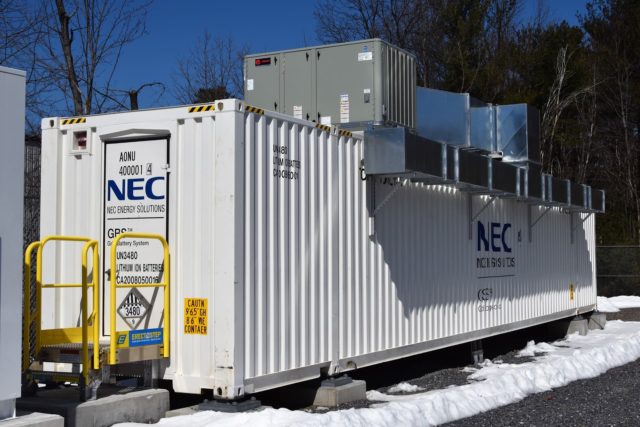Small Community Saves Big with Energy Storage
 The little town of Sterling, MA is getting a lot of attention these days. Not only has the Sterling Municipal Light Department (SMLD) won awards for its new solar+storage microgrid, the town is getting visitors from Germany, Japan, Norway and many other countries. The visitors come to see an innocuous-looking metal box at the utility’s electrical substation; the box houses 2 megawatts of lithium-ion batteries, capable of nearly four hours of continuous maximum discharge. The batteries, along with a 3 MW solar array, can be islanded in case of a power outage and will support the town’s police station and emergency dispatch center for at least two weeks – more with solar recharging – meaning Sterling’s first responders will be able to help people in need if a natural disaster knocks out the regional grid. But these resilient power benefits, however important, are not the reason for all the attention.
The little town of Sterling, MA is getting a lot of attention these days. Not only has the Sterling Municipal Light Department (SMLD) won awards for its new solar+storage microgrid, the town is getting visitors from Germany, Japan, Norway and many other countries. The visitors come to see an innocuous-looking metal box at the utility’s electrical substation; the box houses 2 megawatts of lithium-ion batteries, capable of nearly four hours of continuous maximum discharge. The batteries, along with a 3 MW solar array, can be islanded in case of a power outage and will support the town’s police station and emergency dispatch center for at least two weeks – more with solar recharging – meaning Sterling’s first responders will be able to help people in need if a natural disaster knocks out the regional grid. But these resilient power benefits, however important, are not the reason for all the attention.
Sterling is in the spotlight because its municipal utility can use the new battery system to control rising power costs. This benefits the town’s ratepayers, but it also benefits the entire New England region; and it means the $2.7 million battery system will pay itself off in about two years, with grant funding from Massachusetts Department of Energy Resources (DOER) and U.S. Department of Energy Office of Electricity (DOE-OE). But even without the grants, the system would still achieve a payback period of fewer than 7 years… pretty good considering that the batteries come with a 10-year performance warranty and are expected to continue to function significantly longer than that.
According to an upcoming paper by Sandia National Laboratory, which provided technical assistance to the Sterling energy storage project, the biggest energy cost savings potential from the batteries comes from reducing Sterling’s electricity demand during a single annual peak demand hour for the New England region. This regional peak demand hour generally occurs in July or August, and each utility in New England is assessed an annual fee for capacity services based on its individual demand during that one hour. Green Mountain Power (GMP), using a similar battery and solar microgrid in Rutland, Vermont, demonstrated the value of capacity charge savings during the 2016 regional peak, on August 12. In one hour that day, GMP saved $200,000 by discharging its batteries to offset electricity purchases from the New England grid operator. Sterling Municipal Light Department will attempt to do the same in 2017 and each year thereafter.
A second source of significant cost savings for SMLD can be achieved by using the batteries to reduce utility transmission charges. These charges are assessed based on a single peak demand hour each month. As with the annual peak, if a utility reduces its demand during the monthly regional peak, it reduces its share of transmission costs for that month. In December 2016, SMLD successfully discharged its batteries during the monthly peak, saving its ratepayers $17,000 for one hour. That’s a significant savings for a municipal utility with an annual budget of $8.2 million. SMLD repeated this performance in March and, with the batteries now fully operational, SMLD hopes to continue to hit monthly peaks on a regular basis.
In addition to these savings, SMLD will use its batteries to engage in arbitrage—that is, discharging the batteries for self-consumption when grid power is priced the highest; and for frequency regulation—a grid-balancing service that batteries can provide, and be paid for.
With all these cost savings and revenues, SMLD conservatively estimates the economic benefits from the batteries are worth $400,000/year to utility’s ratepayers. Of course, that doesn’t include some of the most significant unpaid benefits of the system, such as integrating the large amount of solar PV on Sterling’s system, reducing emissions from fossil fueled power plants, and providing backup power in case of a natural disaster that knocks out the regional grid. It’s no wonder Sterling’s success is being closely watched by many other municipal utilities and electric coops in New England, several of which are actively working to build their own battery systems.
So, what does all this mean for the regional grid? For 100 years, the electric grids have been based on big, centrally-located fossil fueled and nuclear generating plants, sending one-way flows of electricity down transmission lines to distribution utilities, who in turn supplied power to their customers. In New England and many other regions, the whole system is regulated by the Independent System Operator (ISO), which makes sure that electricity supply exactly meets demand in real time. That means that every day, the ISO is signaling expensive and highly polluting gas ‘peaker’ plants to ramp their generation up and down, following a fluctuating load.
That’s all about to change. If a small municipal utility like Sterling can save big money by relying on its own batteries rather than expensive peaker plants, other utilities can do the same. And when enough utilities install batteries, it will change the face of the grid. It will mean more renewables can be deployed, without the intermittency that can cause demand spikes; more grid services can be provided by distributed resources, increasing competition and opening markets; and more municipalities can take control of their energy purchases and costs. It will also mean more energy resiliency in local communities, where solar+storage can provide critical backup power during emergencies. That’s a new electricity business model that lowers costs, is good for the environment, and potentially saves lives.
***
In a webinar on Tuesday, April 27, guest speakers from SMLD, Sandia, and DOE previewed Sandia’s soon-to-be-published paper on the economics of the Sterling microgrid. This webinar was hosted by the Clean Energy States Alliance (CESA) as part of the Energy Storage Technology Advancement Partnership (ESTAP). Slides and a recording of this webinar are available here.
Published On
April 14, 2017

